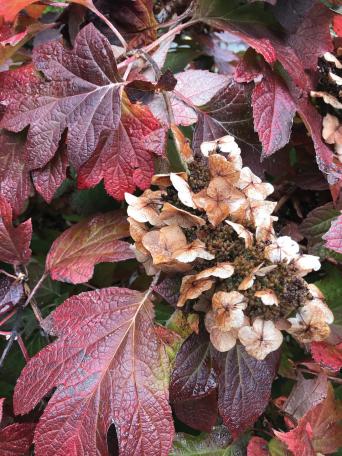
Liberate Your Lawn & Garden: Here’s the Science Behind the Fiery Natural Colors of Fall
“Oh mom, look at that!”
My daughter and I were on our way home when we were greeted by an incredible ray of light setting the tops of the trees ablaze. They were literally glowing yellow with red and orange highlights dancing in the light. For just a minute, the world around us dropped away as we took in this breathtaking sight.
Fall is my favorite time of year. I love the smell of decaying leaves and woodfire smoke on a brisk day, the yellow “glow” walking among American beech or birch trees and the tapestry of yellows, oranges and reds standing in stark contrast to a brilliant blue fall sky. After the intense heat and green of summer, fall is like a big sigh that allows us to pause, take in the subtle shifts of color and look at our landscape in a new way.
Why do leaves change color and why does one plant turn yellow while the other turns red? It’s a question I have often asked myself but never actively sought an answer to until recently. I thought I would share what I found because knowing the what and why of how our plants work makes them even more special!
Leaves change color because of the chemical compounds or pigments found in them and because of the change in weather.
There are three main types of pigment found in each leaf: chlorophyll (green), carotenoids (yellow and orange) and anthocyanins (red). These pigments reflect and absorb certain wavelengths of visible light and are visible based on photosynthesis — the process by which light energy is converted to chemical energy and stored as carbohydrates (sugar) which allows plants to grow, flower and produce seed.
Chlorophyll, the green pigment in leaves, is the chemical responsible for photosynthesis. Each leaf is a small factory that transforms water, supplied by the roots, and carbon dioxide into oxygen and carbohydrates, which are transported to every other part of the plant. During this process, two different types of chlorophyll absorb and hold onto red and blue light from the sun, reflecting the color green.
Bright sunlight causes chlorophyll to constantly break down; therefore, to maintain the amount needed, plants must continually synthesize it. This requires sunlight and warm temperatures to keep water and nutrients flowing. During the summer the process is continuous. But in the fall, as nights slowly get longer, the reduction of light and cooler temperatures is a signal to plants to begin to prepare for the winter ahead. The flow of nutrients slows, and chlorophyll degrades rapidly, allowing pigments responsible for reds, oranges and yellows to become visible.
Carotenoid and anthocyanin leaf pigments at the most basic level aid in the process of photosynthesis by absorbing different color light. Carotenoids absorb energy from blue-green and blue light and transfer that energy back to the chlorophyll. Carotenoids essentially protect chlorophyll from oxidation. Leaves contain more chlorophyll than carotenoids, so we don’t see yellow and orange while chlorophyll is present.
The same is true of anthocyanins, which not all plants contain. They absorb blue, blue-green and green light and reflect red. Unlike chlorophyll and carotenoid pigments, anthocyanins are produced during an energy-consuming process that is initiated by sunlight. Therefore, leaves will be reddest on the sunny side of the tree. If you see a sugar maple or red oak, take note of which direction the most vibrant red leaves face!
Lastly, the range of fall color is always influenced by weather. Warm, wet weather delays the destruction of chlorophyll and the appearance of carotenoids and anthocyanins, whereas cool, dry weather favors it. And sunny weather promotes the production of anthocyanins. This means that the brightest fall colors are produced when dry, sunny days are followed by cool, dry nights. So far, all signs are pointing to a brilliant fall!
Sarah Endriss is an ecologic restoration design professional. She is principal of Asarum LandDesign Group, adjunct faculty at Jefferson University and a restoration design consultant for WildLawn, an ecological alternative to the suburban lawn.


